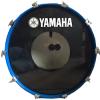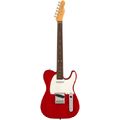Getting a punchy kick (so to speak)

Membre
Posts: 522
Joined: 27 févr. 2015
No matter how many times I set up my kit for recording, I can't get my kick to punch through. There's nothing wrong with the kick itself (a Yamaha 9000 with a Remo Powerstroke3 batter head on it - acres of power and punch) or the mic (an AKG D112). But once I get things mixed together, the kick disappears into to woofy punch rather than a nice punchy click with lots of bottom end presence.
I've tried some EQ settings (such as the classic EQ dip around 160Hz and also upping the mid-highs), tried various compressions, both standard and multi-band. I don't use gates as a rule. I just can't seem to get a good punch and the kick disappears into the world of sub-woofers once everything starts getting added on.
Any top tips? I'm using Reaper and only have the standard AUs and VSTs that it came with to play with.
Thanks for any advice.
I've tried some EQ settings (such as the classic EQ dip around 160Hz and also upping the mid-highs), tried various compressions, both standard and multi-band. I don't use gates as a rule. I just can't seem to get a good punch and the kick disappears into the world of sub-woofers once everything starts getting added on.
Any top tips? I'm using Reaper and only have the standard AUs and VSTs that it came with to play with.
Thanks for any advice.

Membre
Posts: 282
Joined: 19 août 2013
I guess, someone will help you better than me. I used a D112 mic to record the drumset in #14848 drumtrack. The second mic was a AGK C1000S. No more mics :). I don't give a advice against this "timbre war" but only this drumtrack to compare your own efforts and sound. :)
I used this simple 2-mic-solution because I recorded on a 8-tracker the whole band at the same time playing live together. There was some overblending in the mics in the rehearsal room.... :). In a band context I reached out for a good cymbals sound as the most important fact to my ears - but it was a challenge to record the band and play a guitar (and sing :) ) at the same time....
I used this simple 2-mic-solution because I recorded on a 8-tracker the whole band at the same time playing live together. There was some overblending in the mics in the rehearsal room.... :). In a band context I reached out for a good cymbals sound as the most important fact to my ears - but it was a challenge to record the band and play a guitar (and sing :) ) at the same time....

Fender AV II 63 TELE RW RED TRANS
Electric Guitar

2.249 €
iThis widget links to Thomann, our affiliate partner. We may receive a commission when you purchase a product there.
Visit Shop
SUPPORTER
Posts: 2953
Joined: 30 déc. 2010
Let me try to add my 0.2 cent here - I believe you are aware there is no "works right away" solution on this, but maybe you can improve your result by following some of below hints.
Now, let me try to find some words to explain what we are talking about here:
When recording a bassdrum, the common first result will sound like "Bhhoom", while we are aiming to record something that would sound like "Thud!" - which cuts thru mixes much better.
So, it's that "smack" sound we'd like to catch - catching lots and lots of bass should not be the problem with your mic - but where is the "smack"?
Search it here:
IMO, the "smack" is happening right where the batter hits the skin - and I have seen pro engineers place a second mic (mostly SM57) outside of the bassdrum, close to the batter to catch that.
If you continue with one mic, placement is crucial - I stopped placing the Bassdrum mic inside the BD long ago - placing it outside and close to the resonating skin gives better results - the resonating skin also creates a little "smack" when not tuned too high - I tend to tune it down as low as possible.
Don't place the mic in the center of the bassdrum skin to avoid frequency confusion (that's a good tip when micing amps as well - never go for the center).
A harder/flat batter will have a little more "smack" than a soft round one, too.
After recording, here are a few EQ & Comp tips:
Lets face it, people listen on devices hardly capable of playing back frequencies below 200Hz these days. I have met pro engineers who made sure their kick was noticeable between 400-500Hz to make sure it still kicks when listened on laptop speakers (yuk!).
Placing a notch filter somewhere between 160 - 80Hz will change the sound from "Bhhoom" to "Bomm", which is a step ahead.
The "smack" is much higher, frequency wise - I'd look for it above 1100Hz, so be carefull with high-cuts!
Now, most bassdrum mics are not as sensitive on these higher frequencies - so you will either have to boost them by EQ or by multiband comp to get a good result.
When doing that, you will definetly boost some non-bassdrum signals coming in thru the mic as well... that's where it does get tricky.
Two approaches seem worth trying: You can just treat the BD signal as hinted at - you might go the other way too, high-cut the BD-mic and search for the "smack" on some other mics - it will definetly be on your overheads, so by combining those signals, one can also reach a nice result.
One problem which is not all obvious is the minimal timing differences between the mics - since the overheads are further away from the bassdrum than the bassdrum mic, the signal will reach them slightly later - which changes the sound & attack of your mix significantly!
I have made a good practise out of delaying all closely miced drums in the mix, so they play in time with the overheads. Think of delays between 4 - 14ms - and I'm not talking about an echo, but a real delay of the signal without any self feedback into the delay (100% effect output, 0% feedback). You will hardly hear the difference at first, it does do some magic to the dynamics tho :)
Last, lets not forget most professional mixes work with ducking/side-chaning nowadays -
that would be the job of your remixers, not yours on wikiloops.
The idea of side-chaning is to lower the volume of anything besides the bassdrum signal when a kick happens, so for a very short time, the kick can cut thru the mix. If configured right, you can reach the real "loudness war" results with this technique, obviously the human ear does not notice that trick in a bad way, but most love the full throttle "thud" and don't notice all other signals have been lowered for a few milliseconds.
Hope some of that may help on your quest - wouldn't say I've totally solved it myself ;)
Now, let me try to find some words to explain what we are talking about here:
When recording a bassdrum, the common first result will sound like "Bhhoom", while we are aiming to record something that would sound like "Thud!" - which cuts thru mixes much better.
So, it's that "smack" sound we'd like to catch - catching lots and lots of bass should not be the problem with your mic - but where is the "smack"?
Search it here:
IMO, the "smack" is happening right where the batter hits the skin - and I have seen pro engineers place a second mic (mostly SM57) outside of the bassdrum, close to the batter to catch that.
If you continue with one mic, placement is crucial - I stopped placing the Bassdrum mic inside the BD long ago - placing it outside and close to the resonating skin gives better results - the resonating skin also creates a little "smack" when not tuned too high - I tend to tune it down as low as possible.
Don't place the mic in the center of the bassdrum skin to avoid frequency confusion (that's a good tip when micing amps as well - never go for the center).
A harder/flat batter will have a little more "smack" than a soft round one, too.
After recording, here are a few EQ & Comp tips:
Lets face it, people listen on devices hardly capable of playing back frequencies below 200Hz these days. I have met pro engineers who made sure their kick was noticeable between 400-500Hz to make sure it still kicks when listened on laptop speakers (yuk!).
Placing a notch filter somewhere between 160 - 80Hz will change the sound from "Bhhoom" to "Bomm", which is a step ahead.
The "smack" is much higher, frequency wise - I'd look for it above 1100Hz, so be carefull with high-cuts!
Now, most bassdrum mics are not as sensitive on these higher frequencies - so you will either have to boost them by EQ or by multiband comp to get a good result.
When doing that, you will definetly boost some non-bassdrum signals coming in thru the mic as well... that's where it does get tricky.
Two approaches seem worth trying: You can just treat the BD signal as hinted at - you might go the other way too, high-cut the BD-mic and search for the "smack" on some other mics - it will definetly be on your overheads, so by combining those signals, one can also reach a nice result.
One problem which is not all obvious is the minimal timing differences between the mics - since the overheads are further away from the bassdrum than the bassdrum mic, the signal will reach them slightly later - which changes the sound & attack of your mix significantly!
I have made a good practise out of delaying all closely miced drums in the mix, so they play in time with the overheads. Think of delays between 4 - 14ms - and I'm not talking about an echo, but a real delay of the signal without any self feedback into the delay (100% effect output, 0% feedback). You will hardly hear the difference at first, it does do some magic to the dynamics tho :)
Last, lets not forget most professional mixes work with ducking/side-chaning nowadays -
that would be the job of your remixers, not yours on wikiloops.
The idea of side-chaning is to lower the volume of anything besides the bassdrum signal when a kick happens, so for a very short time, the kick can cut thru the mix. If configured right, you can reach the real "loudness war" results with this technique, obviously the human ear does not notice that trick in a bad way, but most love the full throttle "thud" and don't notice all other signals have been lowered for a few milliseconds.
Hope some of that may help on your quest - wouldn't say I've totally solved it myself ;)

Membre
Posts: 522
Joined: 27 févr. 2015
Thank you for that comprehensive reply, Dick! Loads of food for thought there.
I'll see what I can do about mic positioning. I already don't put the mic 'in' the bass drum because the D112 doesn't fit very well because of the XLR sticking out of the bottom. I have a pillow in my kick so the reso head doesn't really serve much purpose - it's a standard Yamaha reso with the big hole in the middle, so I might have a play with using lesser damping.
My main problem is that I'm mixing on headphones (several pairs which I switch between when mixing) - I don't have a set of studio monitors. They're on my to-buy list but I'm between jobs at the moment so such expenditure wouldn't be wise!
Some of the tricks I'd heard of, but delaying the kick signal is a very interesting one. I guess I could achieve the same effect but just shifting the whole wav by a few ms?
Thank you for your input - I'll see what I can achieve!
I'll see what I can do about mic positioning. I already don't put the mic 'in' the bass drum because the D112 doesn't fit very well because of the XLR sticking out of the bottom. I have a pillow in my kick so the reso head doesn't really serve much purpose - it's a standard Yamaha reso with the big hole in the middle, so I might have a play with using lesser damping.
My main problem is that I'm mixing on headphones (several pairs which I switch between when mixing) - I don't have a set of studio monitors. They're on my to-buy list but I'm between jobs at the moment so such expenditure wouldn't be wise!
Some of the tricks I'd heard of, but delaying the kick signal is a very interesting one. I guess I could achieve the same effect but just shifting the whole wav by a few ms?
Thank you for your input - I'll see what I can achieve!
SUPPORTER
Posts: 2953
Joined: 30 déc. 2010
I have no experience with those big-holed yamaha resos TBH - hard to say what it does, you'll have to experiment a little.
I have been using a remo (foam ring) muffler on my 22" BD for a long time, its a quite heavy way to dampen a bassdrum, but I never went for that long resonating jazz bassdrum sound, so I quite like the effect.
You are correct about the "move wav" approach - somehow, using a delay always felt more convenient to me, since it will work regardless of any cut & paste jobs on your wav and the grid settings.
I dont think the headphones are a big problem here - of course good monitoring is important & worth spending some cash, thats a seperate story tho.
Listening to your mix with a low cut at 200Hz on the headphones should give you some idea how your kick is punching when there literally is no bass available.
When listening to ZamZams tracks and their remixes, I recently noticed how his kicks always feel too loud in the pure drums track, but feel just right and powerfull once some instruments are added... maybe that is one of the secrets, too :)
I have been using a remo (foam ring) muffler on my 22" BD for a long time, its a quite heavy way to dampen a bassdrum, but I never went for that long resonating jazz bassdrum sound, so I quite like the effect.
You are correct about the "move wav" approach - somehow, using a delay always felt more convenient to me, since it will work regardless of any cut & paste jobs on your wav and the grid settings.
I dont think the headphones are a big problem here - of course good monitoring is important & worth spending some cash, thats a seperate story tho.
Listening to your mix with a low cut at 200Hz on the headphones should give you some idea how your kick is punching when there literally is no bass available.
When listening to ZamZams tracks and their remixes, I recently noticed how his kicks always feel too loud in the pure drums track, but feel just right and powerfull once some instruments are added... maybe that is one of the secrets, too :)
wikiloops online jamsessions are brought to you with friendly
support by:

I know it's not much but my support is given, better days will come ... Thanks for creating this great Wikiloops community ...
Tutama